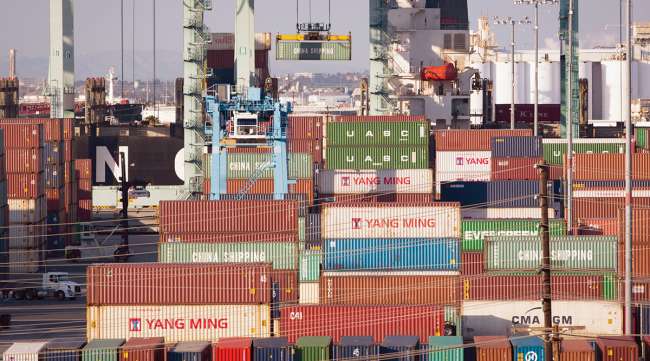Senior Reporter
NRF Report Points to Tariffs as Key Reason for Port Slowdown

[Stay on top of transportation news: Get TTNews in your inbox.]
U.S. import container volumes are expected to show a nearly 1% drop when the final numbers for 2019 are in, the National Retail Federation and Hackett Associates said.
The organizations point to the U.S.-China trade rift as the cause. Imports are projected to reach 21.6 million 20-foot equivalent units (TEUs) in 2019. That compares with the record 21.8 million TEUs in 2018. NRF and economists say that in 2018, many importers front-loaded shipments to the U.S. to get ahead of the anticipated tariffs.
The groups issued their joint report Jan. 9.

Gold
“We’ll be more confident after we see the phase one agreement signed, but right now 2020 looks like it should be back to what used to be normal,” Jonathan Gold, NRF vice president for Supply Chain and Customs Policy, said in a statement. “We’ve been through a cycle of imports surging ahead of expected tariff increases — some of which got delayed, reduced or canceled — and falling off again afterward. That’s not good for retailers trying to manage their inventory levels or trying to make long-term business plans. And tariffs are never good for consumers, businesses or the economy.”
Even as President Donald Trump and Chinese officials are scheduled to sign phase one in Washington on Jan. 15, the president is signaling he could wait until after the 2020 election to negotiate a phase two agreement. The administration said it would lower tariffs that took effect in September and postpone others that were set to take effect Dec. 15. However, other tariffs imposed earlier will remain in effect while negotiations on phase two continue.
NRF is forecasting the volume for 2019 still will be strong when compared with the rest of the decade and second only to 2018’s record.

The federation’s November report showed the ports in their survey handled 1.67 million TEUs. That’s the last month in which full numbers are available, and it marks a 7.7% drop year-over-year from 2018, when ports moved 1.81 million TEUs. “With on-again, off-again progress on trade negotiations reported throughout the fall and other factors affecting shipping, an expected surge ahead of the canceled December tariff increase did not materialize,” the report said.
Two recent studies by economists with the Federal Reserve say the Trump administration’s tariffs are damaging the U.S. economy. One report, written for the Fed by Princeton and Columbia University economists, said the import tariffs were costing U.S. consumers and the firms that import foreign goods an additional $3 billion per month in added tax costs and another $1.4 billion per month in deadweight welfare (efficiency) losses.
Another report released Dec. 23 by Federal Reserve Board economists also was critical of the trade war. It found that any positive effects the tariffs offered American businesses, their costs outweighed the damage done to businesses. This report looked specifically at the impact tariffs were having on the U.S. manufacturing sector. Manufacturing employment was reduced by 1.4%, and producer prices have increased by 4.1%.
“It is not surprising that even the Federal Reserve suggests that the impact of the trade war has a negative impact on the U.S. economy,” Hackett Associates founder Ben Hackett said. “This combination of reduced output counterbalanced by increased inventory underlies the uncertainties of the tariff wars.”
During the past several months, several ports covered by the Global Port Tracker have reported decreased activity. Most of them have been on the West Coast because those facilities rely heavily on ship traffic from China. Port of Los Angeles Executive Director Gene Seroka has been critical of the tariffs, saying they jeopardize 1.5 million U.S. jobs and nearly $190 billion in economic activity.
The Global Port Tracker is produced for NRF by Hackett Associates. It covers:
- Port of Los Angeles.
- Port of Long Beach, Calif.
- Port of Oakland, Calif.
- Port of Seattle.
- Port of Tacoma, Wash.
- Port of New York and New Jersey.
- Port of Virginia.
- Port of Charleston, S.C.
- Port of Savannah, Ga.
- Port Everglades (Fort Lauderdale, Fla.). • Port Miami.
- Port of Jacksonville, Fla.
- Port Houston.
NRF believes volume at the ports will start slowly in the first quarter of the year, then return to normal by spring and summer.
January is projected to see 1.8 million TEUs processed, down 5% from the same period in 2019. February is forecast to show a 4.9% decline of 1.54 million TEUs. But March could see a 5.2% uptick in part because of fluctuations in the Lunar New Year calendar and factory shutdowns in Asia during the holiday. April is forecast at 1.78 million TEUs, up 2.1% year-over-year. May also is expected to be healthy at 1.87 million TEUs as summer merchandise arrives, up 1% year-over-year.
Want more news? Listen to today's daily briefing:



